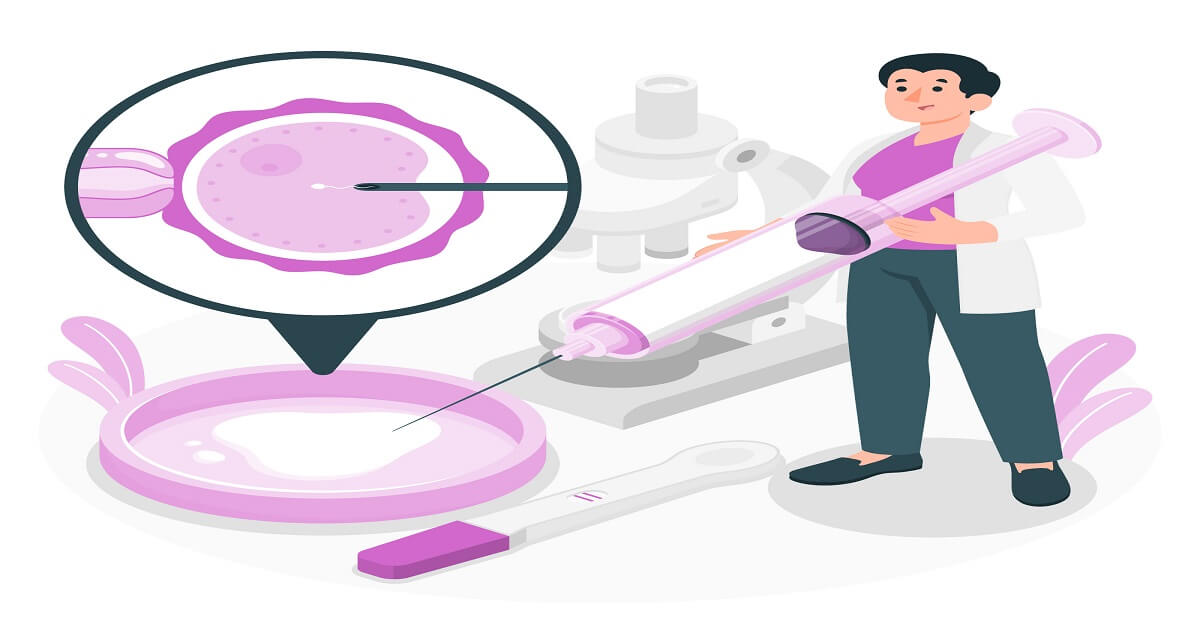Difference Between Natural IVF vs Conventional IVF
What is Natural IVF?
Natural IVF, also known as Mini IVF or Minimal Stimulation IVF, is an innovative approach that differs from Conventional IVF in its use of minimal or no ovarian stimulation medications. Instead of stimulating the ovaries to produce multiple eggs, as in Conventional IVF, Natural IVF relies on the natural, spontaneous development of a single egg during a woman’s menstrual cycle.
Procedure of Natural IVF:
- Monitoring the Natural Cycle: The process begins by closely monitoring a woman’s menstrual cycle. This monitoring involves tracking the growth of a follicle (a fluid-filled sac in the ovary that contains an egg) using ultrasound and hormone tests.
- Egg Retrieval: Once the follicle reaches an appropriate size, a minor surgical procedure known as egg retrieval is performed. This involves aspirating the mature egg from the follicle using a thin needle.
- Fertilization: The retrieved egg is then fertilized with sperm in the laboratory. This can be achieved through traditional insemination or intracytoplasmic sperm injection (ICSI), depending on the specific circumstances.
- Embryo Transfer: After fertilization, the resulting embryo(s) are cultured in the laboratory for a few days until they reach the appropriate stage of development. Then, one or more embryos are selected for transfer into the woman’s uterus.
Benefits of Natural IVF:
- Minimized Medication: One of the primary advantages of Natural IVF is the reduced use of ovarian stimulation medications, which can lead to fewer side effects and complications.
- Lower Cost: Natural IVF tends to be more cost-effective than Conventional IVF because it requires fewer medications and monitoring appointments.
- Lower Risk of Ovarian Hyperstimulation Syndrome (OHSS): Since Natural IVF avoids high doses of ovarian stimulation medications, the risk of OHSS, a potentially serious condition, is significantly reduced.
- Reduced Multiple Pregnancy Risk: Natural IVF typically results in the transfer of a single embryo, minimizing the risk of multiple pregnancies compared to Conventional IVF.
What is Conventional IVF?
Conventional IVF, also referred to as Standard IVF, is the traditional approach to IVF treatment. It involves stimulating the ovaries with hormonal medications to produce multiple eggs, which are then retrieved and fertilized in the laboratory.
Procedure of Conventional IVF:
- Ovarian Stimulation: In Conventional IVF, a woman undergoes a series of hormone injections to stimulate her ovaries to produce multiple eggs. These injections are administered over a span of about 10-12 days.
- Monitoring: Throughout the stimulation phase, the patient undergoes frequent monitoring through blood tests and ultrasounds to track the growth and development of multiple follicles.
- Egg Retrieval: Once the follicles have reached the desired size, egg retrieval is performed. This procedure is similar to Natural IVF and involves the aspiration of mature eggs from the ovaries.
- Fertilization and Embryo Culture: The retrieved eggs are combined with sperm in the laboratory, and the resulting embryos are cultured for several days.
- Embryo Transfer: Typically, multiple embryos are created and cultured. The best-quality embryos are selected for transfer into the uterus, often with the option to freeze any remaining embryos for future use.
Benefits of Conventional IVF:
- Higher Success Rates: Conventional IVF tends to yield a higher number of embryos, which can lead to higher success rates, especially for individuals with specific fertility challenges.
- More Embryos for Freezing: The surplus embryos generated in Conventional IVF can be cryopreserved for future use, offering more opportunities for future pregnancies without the need for another egg retrieval.
- Customized Medication Adjustments: The use of ovarian stimulation medications allows for precise control over egg production, making it suitable for women with certain infertility issues.
- Suitable for Various Conditions: Conventional IVF is often recommended for couples with more complex infertility issues, such as male factor infertility or advanced maternal age.
Success Rate of Natural IVF vs. Conventional IVF in India
Natural IVF Success Rate:
Natural IVF is often chosen for its more gentle approach to fertility treatment. However, its success rates may vary depending on several factors, including the patient’s age and specific fertility issues.
- Age: Younger women generally have higher success rates with Natural IVF, as they tend to produce healthier eggs. The success rate for women under 35 may be around 10-15%, while it decreases for older women.
- Fertility Diagnosis: The underlying fertility diagnosis plays a significant role. Natural IVF may be less effective for individuals with complex infertility issues, such as tubal blockages or severe male factor infertility.
- Quality of Eggs: The success of Natural IVF relies on the quality of the single egg produced naturally. If the egg is of good quality and fertilizes successfully, the chances of a successful pregnancy increase.
Conventional IVF Success Rate:
Conventional IVF typically yields higher success rates due to the retrieval and fertilization of multiple eggs, providing more opportunities for embryo selection. In India, the success rates for Conventional IVF can vary but tend to be higher than those of Natural IVF.
- Age: Age remains a significant factor, with younger women experiencing better outcomes. Success rates for women under 35 can range from 30% to 40% or even higher.
- Diagnosis: Conventional IVF is suitable for a broader range of fertility diagnoses, including cases where multiple eggs are necessary to increase the chances of success.
- Embryo Selection: The availability of multiple embryos allows for a more rigorous selection process, enhancing the likelihood of transferring high-quality embryos.
Risks of Natural IVF vs. Conventional IVF in India
Risks of Natural IVF:
While Natural IVF is considered a less invasive option, it is not entirely without risks:
- Lower Egg Yield: The primary risk of Natural IVF is the potential for a low egg yield. Since only one egg is retrieved, there is a higher risk of cycle cancellation if the egg does not develop appropriately.
- Lower Success Rates: Due to the limited number of eggs, the success rates for Natural IVF may be lower, especially for women with age-related fertility issues.
- Emotional Impact: The emotional toll of undergoing multiple cycles of Natural IVF without success can be challenging for individuals and couples.
Risks of Conventional IVF:
Conventional IVF, while more effective, comes with its own set of risks:
- Ovarian Hyperstimulation Syndrome (OHSS): The use of ovarian stimulation medications in Conventional IVF can lead to OHSS, a potentially severe condition characterized by abdominal pain, bloating, and fluid retention.
- Multiple Pregnancies: The transfer of multiple embryos increases the risk of multiple pregnancies, which can lead to complications for both the mother and the babies.
- Medication Side Effects: The hormonal medications used in Conventional IVF can cause side effects like mood swings, hot flashes, and headaches.
Cost of Natural IVF vs. Conventional IVF in India
Cost of Natural IVF:
In India, Natural IVF is generally more cost-effective compared to Conventional IVF. This affordability is attributed to the reduced use of expensive ovarian stimulation medications and fewer monitoring appointments. The approximate cost of a single cycle of Natural IVF in India can range from INR 50,000 to INR 1,50,000, making it a more accessible option for many couples.
Cost of Conventional IVF:
Conventional IVF is typically more expensive in India due to the higher cost of ovarian stimulation medications, extensive monitoring, and the use of specialized laboratory techniques. The cost of a single cycle of Conventional IVF can vary widely, ranging from INR 1,50,000 to INR 3,50,000 or more.
Conclusion:
Natural IVF and Conventional IVF represent two distinct approaches to assisted reproduction, each with its own set of advantages and considerations. The choice between the two depends on a variety of factors, including the individual’s medical history, fertility diagnosis, and personal preferences. Both methods have enabled countless individuals and couples to realize their dreams of becoming parents, offering hope and advanced medical solutions in the journey toward parenthood. Consulting with a fertility specialist is essential to determine the most suitable approach for one’s unique circumstances and goals.


